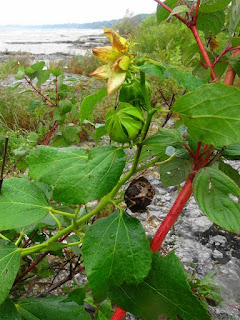If you spend much time in meadow marsh habitat you get familiar with a diversity of sedges and rushes. The one below is Common Three-square (Schoenoplectus pungens). This stand was in an area which a local told us had once been a vast expanse of meadow marsh prior to development and boat traffic. Wild Rice (Zizania spp.) was once rather abundant here.
Clammyweed (Polanisia dodecandra) is sticky to the touch as the name suggests. I found the smell of the oily substance to have the odour of diesel fuel. This species is largely found in beach habitats but can also occur inland on gravelly bluffs and other similar habitats.
Another beach species, Sandbur (Cenchrus longispinus) is one you definitely know when it's stuck in your socks!
 |
| A Bugseed (Corispermum spp.), of which Niagara has a few. |
 |
| The rain pounded and the wind howled...all...day...long. |
The point is home to Niagara Region's only population of Sand Cherry (Prunus pumila).
An iconic (and uncommon) wildflower of Lake Erie coastal marsh habitats, Swamp Rose-Mallow (Hibiscus moscheutos). When in flower the large, pink hibiscus flowers are hard to miss.
 |
| The uncommon Pringle's Aster (Symphyotrichum pilosum var. pringlei). |
How about that. The one and only extant population of Kalm's St. John's-wort (Hypericum kalmianum) in all of Niagara Region. That's it, everything in the frame of this photo.
 | |
| Buttonbush (Cephalanthus occidentalis) fruits had turned a deep red. |












